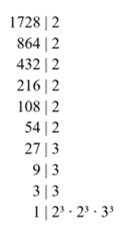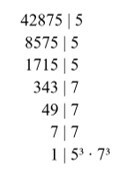THE root cubic is the root operation that has an index equal to 3. Calculate the cube root of a number no is to find which number to the power of 3 results in no, this is, \(\sqrt[3]{a}=b\rightarrow b^3=a\). Therefore, the cube root is a particular case of root.
Know more: Square root — how to calculate?
Representation of the cube root of a number
We know as a cube root the operation of rooting a number no when the index is equal to 3. In general, the cube root of no is represented by:
\(\sqrt[3]{n}=b\)
3→ cube root index
no →rooting
B → root
How to calculate the cube root?
We know that the cube root is a root with index equal to 3, so calculate the cube root of a number no is to find which number multiplied by itself three times is equal to no. That is, we are looking for a number B such that B³ = no. To calculate the cube root of a large number, we can perform the number factorization and group the factorizations as potencies with an exponent equal to 3 so that it is possible to simplify the cube root.
Example 1:
calculate \(\sqrt[3]{8}\).
Resolution:
We know that \(\sqrt[3]{8}=2\), because 2³ = 8.
Example 2:
Calculate: \(\sqrt[3]{1728}.\)
Resolution:
To calculate the cube root of 1728, we will first factor out 1728.

So we have to:
\(\sqrt[3]{1728}=\sqrt[3]{2^3\cdot2^3\cdot3^3}\)
\(\sqrt[3]{1728}=2\cdot2\cdot3\)
\(\sqrt[3]{1728}=12\)
Example 3:
Calculate the value of \(\sqrt[3]{42875}\).
Resolution:
To find the value of the cube root of 42875, you need to factor this number:

So we have to:
\(\sqrt[3]{42875}=\sqrt[3]{5^3\cdot7^3}\)
\(\sqrt[3]{42875}=5\cdot7\)
\(\sqrt[3]{42875}=35\)
List of exact cube roots
\( \sqrt[3]{0}=0\)
\( \sqrt[3]{1}=1\)
\( \sqrt[3]{8}=2\)
\( \sqrt[3]{27}=3\)
\( \sqrt[3]{64}=4\)
\( \sqrt[3]{125}=5\)
\( \sqrt[3]{216}=6\)
\( \sqrt[3]{343}=7\)
\( \sqrt[3]{512}=8\)
\( \sqrt[3]{729}=9\)
\( \sqrt[3]{1000}=10\)
\( \sqrt[3]{1331}=11\)
\( \sqrt[3]{1728}=12\)
\( \sqrt[3]{2197}=13\)
\( \sqrt[3]{2744}=14\)
\( \sqrt[3]{3375}=15\)
\( \sqrt[3]{4096}=16\)
\( \sqrt[3]{4913}=17\)
\( \sqrt[3]{5832}=18\)
\( \sqrt[3]{6859}=19\)
\( \sqrt[3]{8000}=20\)
\( \sqrt[3]{9281}=21\)
\( \sqrt[3]{10648}=22\)
\( \sqrt[3]{12167}=23\)
\( \sqrt[3]{13824}=24\)
\( \sqrt[3]{15625}=25\)
\( \sqrt[3]{125000}=50\)
\( \sqrt[3]{1000000}=100\)
\( \sqrt[3]{8000000}=200\)
\( \sqrt[3]{27000000}=300\)
\( \sqrt[3]{64000000}=400\)
\( \sqrt[3]{125000000}=500\)
\( \sqrt[3]{1000000000}=1000\)
Important: The number that has an exact cube root is known as a perfect cube. So the perfect cubes are 0, 1, 8, 27, 64, 125, 216, etc.
Calculation of the cube root by approximation
When the cube root is not exact, we can use approximation to find the decimal value that represents the root. For that, it is necessary to find out between which perfect cubes the number lies. We then determine the range that the cube root is in, and finally we will find the decimal part by trial by analyzing the variability of the decimal part.
Example:
calculate \(\sqrt[3]{50}\).
Resolution:
Initially, we will find between which perfect cubes the number 50 is:
27 < 50 < 64
Calculating the cube root of the three numbers:
\(\sqrt[3]{27}
\(3
The integer part of the cube root of 50 is 3 and is between 3.1 and 3.9. Then, we will analyze the cube of each of these decimal numbers, until it goes beyond 50.
3,1³ = 29,791
3,2³ = 32,768
3,3³ = 35,937
3,4³ = 39,304
3,5³ = 42,875
3,6³ = 46,656
3,7³ = 50,653
So we have to:
\(\sqrt[3]{50}\approx3.6\) for lack.
\(\sqrt[3]{50}\approx3,7\) by excess.
Also know: Calculation of non-exact roots — how to do it?
Cube root solved exercises
(IBFC 2016) The result of the cube root of the number 4 squared is a number between:
A) 1 and 2
B) 3 and 4
C) 2 and 3
D) 1.5 and 2.3
Resolution:
Alternative C
We know that 4² = 16, so we want to calculate \(\sqrt[3]{16}\). The perfect cubes we know next to 16 are 8 and 27:
\(8<16<27\)
\(\sqrt[3]{8}
\(2
So the cube root of 4 squared is between 2 and 3.
question 2
The cube root of 17576 is equal to:
a) 8
B) 14
C) 16
D) 24
E) 26
Resolution:
Alternative E
Factoring 17576, we have:

Therefore:
\(\sqrt[3]{17576}=\sqrt[3]{2^3\cdot{13}^3}\)
\(\sqrt[3]{17576}=2\cdot13\)
\(\sqrt[3]{17576}=26\)
By Raul Rodrigues de Oliveira
Maths teacher
Source: Brazil School - https://brasilescola.uol.com.br/matematica/raiz-cubica.htm



